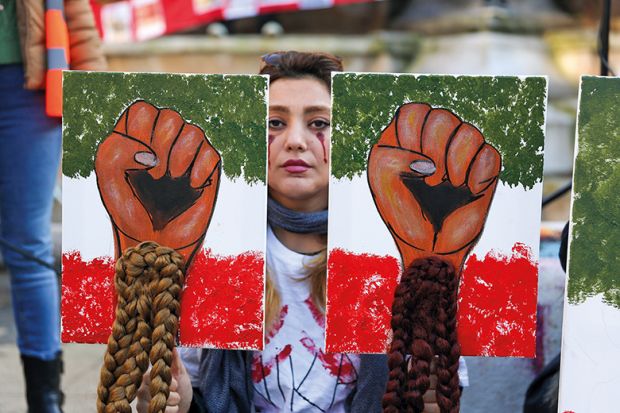Historically, in Iran as in other countries, universities had a central place in civil protests. But the new round of campus protests, which began more than two months ago following the death of Mahsa Amini in police custody, was quite a surprise.
Throughout my university years in Iran, I have never seen students protesting the way they do these days. I can remember a series of campus protests long ago, when I was still a BA student, in memory of the July 1999 disaster at Tehran University in which protesters were attacked and several students were killed, injured or disappeared. Students also protested in 2009, when I was an MA student, in the spirit of what is known as the Green Movement, which unsuccessfully demanded the removal of Mahmoud Ahmadinejad as president.
Then, for years, Iranian universities were largely quiet, with just occasional, scattered protests. Politics remained the main topic of debate among students, but they were not willing to walk the walk. It felt like Iranian academia was going through a phase of chronic depression in terms of socio-political activism. But now it has come out of it – and come out hard.
Compared with the past, the current campus protests are remarkably broad-based, involving universities all over the country. And students seem to be more determined this time. Back in the old days, most were concerned about their future careers; they didn’t want to ruin their chances of being employed in the public sector. Having the same concern, their families would also discourage them from taking part in protests. But the economic crises of recent years have largely destroyed such career hopes, while public-sector employment has, besides, been made unattractive by rampant inflation, with which wages have not kept pace.
Of course, academics don’t show as much courage as their students do, given the risk of losing their jobs. But students are not impressed. One of the many letters students have written to their professors reads: “Your deliberate silence concerning recent events at universities is of such a huge political significance that you will not be able to shirk in the future.”
Even so, the engagement of university professors seems quite considerable compared with similar cases in the past. Many have voiced solidarity with the protesting students, and some have even broken off their lectures in protest at the imprisonment of their students. And while universities still aren’t playing the central role in the protests, it is interesting how the inclusive nature of the current protest makes it quite inconvenient even for unobtrusive professors to stay in their comfort zones.
The broad base of the protests suggests that they are reaching what sociologists identify as the coalescence stage: the stage at which movements acquire popularity and organisation. But the movement’s innovative character is even more remarkable than its comprehensiveness. Take the slogans. A lot of debate has been stoked by the replacement of the traditional calls for progressive reforms with profanity and revolutionary demands at the country’s highest ranked universities.
What particularly attracts attention is challenging gender policies. Nowadays, many schoolgirls in Iran take off their hijabs in public areas as a way to protest. But when university students do the same on campus, it means challenging gender policies within official contexts.
Particularly striking was when students started to challenge segregation. One day, for instance, students of both genders at Tehran’s Sharif University decided to go to the same campus restaurant for lunch. Security tried to stop them, so, instead, they ate together in the open area outside the restaurant. Students at other universities have followed suit.
What started as part of the campus protests raised awareness of the nonsensicality of a convention lasting more than 40 years: one that I never heard students seriously question in my day even though we could have our meals together in any off-campus restaurant. Nor did we question the requirement that male and female students sit in two different columns in class or sleep in separate dormitories built quite far from one another.
Will the protests result in real changes? I am yet not sure about that. What is important, though, is that they speak to a higher level of awareness, as well as a new form of activism. As a number of research works suggest, universities can play a crucial role in political protests by providing focal points for networking and organisation. That is especially the case for universities in Iran because protest networking is seriously obstructed outside campuses.
A protest poster on the wall at Allameh Tabataba'i University speaks to how Amini’s death – after she was arrested by the morality police for not wearing an approved hijab – has turned students’ focus from the mundanities of everyday life to thoughts of revolution: “We were ordinary people. We used to write and take photo of tables and chairs laid at the cafe, autumn trees, clasped hands, and other things, but you made us overly politicised.”
Iranian universities may not be spearheading the protests just yet, but it may only be a matter of time before they do.
Roohola Ramezani has a PhD in philosophy from Shahid Beheshti University, Tehran. He has been a research fellow at the IFK International Research Center for Cultural Studies in Vienna. His research interests include various topics in science studies, social epistemology and Iranian studies.
POSTSCRIPT:
Print headline: Iranian students protest, but academics are wary
Register to continue
Why register?
- Registration is free and only takes a moment
- Once registered, you can read 3 articles a month
- Sign up for our newsletter
Subscribe
Or subscribe for unlimited access to:
- Unlimited access to news, views, insights & reviews
- Digital editions
- Digital access to THE’s university and college rankings analysis
Already registered or a current subscriber? Login








